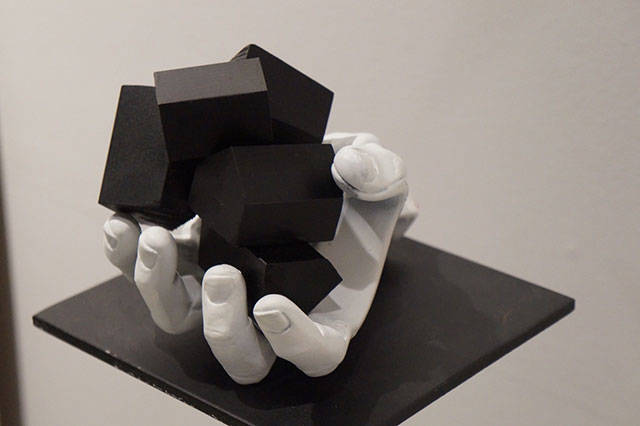By Juli Goetz Morser
For Vashon Center for the Arts
In recognition of Black History Month, Vashon Center for the Arts will present “Warren Pope: Blood Lines, Red Lines,” a solo exhibition by a celebrated West Seattle artist who meets the topic of racism head-on.
The exhibition opens, with Pope in attendance, at 6 p.m. Friday, Feb. 7, and will run through Saturday, Feb. 29.
Warren Pope creates abstract mixed media and contemporary sculpture from such materials as canvas, wire, steel, banana leaves and wood. Yet his subject matter is far from an abstraction — it speaks to the destructive legacy and harsh current realities of social injustice against people of color.
The titles of the works ensure there is no doubt about the artist’s vision and statement.
“One work is called ‘Recolonization’ — it’s a very tech piece about redlining, but it comes out of my experience,” Pope said. “‘Incarcerated in My Own Skin,’ is the name of another piece — it will steal your heart.”
As the son of an African American father and a white Czech mother, Pope traveled with his family between Harlem, N.Y.; Tacoma, Wash.; North Carolina; Kansas; and Munich, Germany, where he was born. His mother taught Pope and his two brothers about art, while his father, who was in the military, taught his sons about their African heritage.
In the show, Pope calls out to that heritage with a series of African masks.
“I love the idea of bloodlines,” he said. “I am challenged by it. I hear people say, ‘African art is primitive,’ but I say, ‘let’s see you do it.’ It’s not primitive if you do it well. I enjoy working on a mask, trying to make it as good as an African piece.”
For Pope, his art is also about the way it is perceived by its viewers.
“This show is about redlining, gentrification and relocation, but I also like to transfer beauty into the place where you look,” he said.
The artist noted that he has been told that his work deeply affects viewers who are both white and African-American and that he feels grateful that his messages resonate. He cited an Instagram post from a young, white woman who wrote under a photo of “American Legacy,” a 60-inch carving with hands reaching out of it, “I haven’t felt this way in a long time. It’s a must-see.”
“If I can relate to a 20-year-old woman, then I know I can reach people,” he said. “At my exhibit last year, I watched a six-foot-two black man well up in tears, profoundly moved by my piece called ‘Sharecroppers.’”
Pope, 72, has lived in Seattle for more than 30 years. A self-proclaimed minimalist — a title that critics have used since his first art show as a junior at the University of Puget Sound in the early 1970s — Pope has exhibited his work at American Art Company and Gallery Mack. His show “Blood Lines, Time Lines, Red Lines” opened at Seattle’s Northwest African American Museum (NAAM) last summer to rave reviews and was extended an extra month due to popular demand.
In an article about the NAAM show in The Seattle Times, Marcus Harrison Green wrote that Pope was “hellbent on walloping the corneas of any Seattleite who believes this city is absolved from a racist past.”
Green contextualized Pope’s artwork by noting that during the 1930s and 40s, Seattle’s communities of color and Jewish population were largely prohibited from buying or residing in many Seattle neighborhoods due to redlining — a denial of services such as mortgages to people of color.
Redlining in many neighborhoods was systematically enforced through housing covenants — agreements written by developers such as the South Seattle Land Company, that specified that “no part of [their] property hereby conveyed shall ever be used or occupied by any person of the Ethiopian [Black], Malay, Hebrew [Jewish] or any Asiatic race.”
While “Red Lines, Blood Lines” will not be Pope’s first showing at VCA, it will be his first solo exhibit at the venue and will include new work plus some pieces from the NAAM show.
“Working with Warren Pope is a pleasure — to experience his vast amount of work, all created with such a poignant narrative,” Lynann Politte, gallery manager of VCA, said. “The exhibit is a visual conversation of systemic inequities of redlining and the historical impact of slavery. The show will intrigue and inspire its audience for both new viewers and those who have followed him over the years.”
Warren will also host a discussion in the VCA gallery for Harbor School students on Friday, Feb. 28. His talk is part of the Harbor School’s Friday Afternoon Guest Speaker series.


